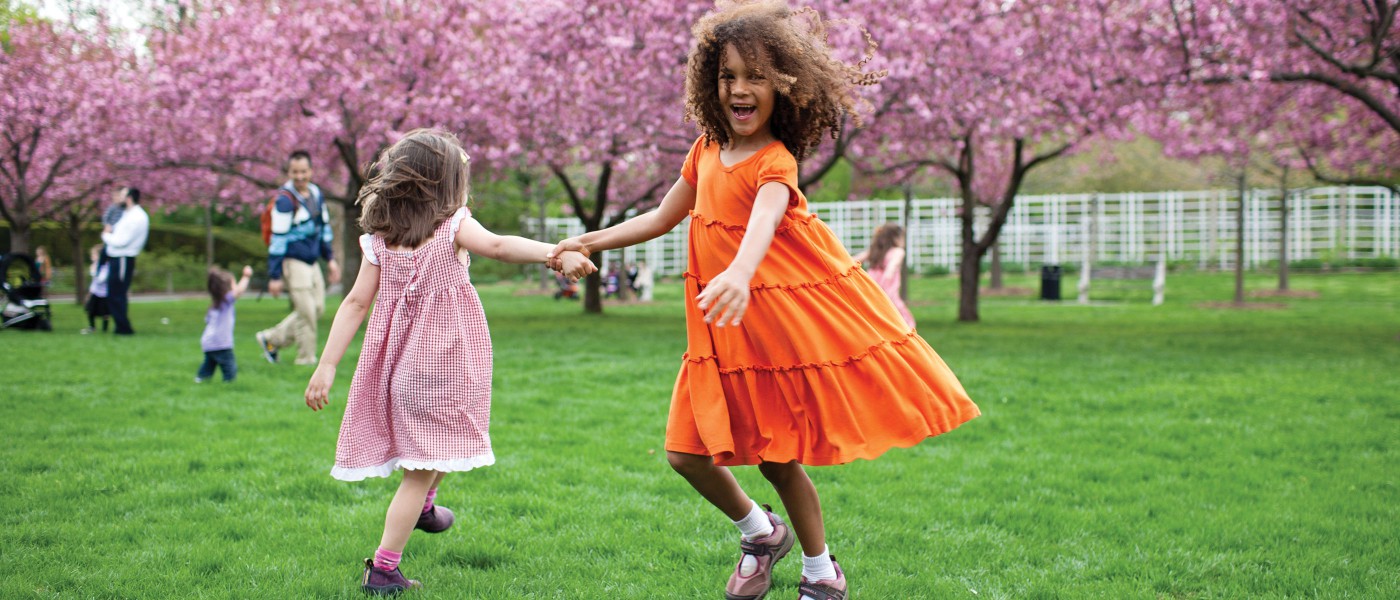The Benefits of Playing in Nature
There’s something that most of us adults took for granted growing up that today’s kids seldom get to do—go outside and play. What was once one of the great simple joys of childhood has now given way to more screen time and more structured activities.
That’s why I’m delighted that the one-acre Discovery Garden for children will open this spring at BBG. This new garden will provide a special environment for families and children’s groups to engage with living plants, in garden areas designed to look, feel, smell, and sound like forest, meadow, and marsh habitats and a cultivated kitchen garden. Here children can immerse themselves in nature and play in ways that have become all too rare. They will become curious, excited, and probably a little bit dirty as they investigate the plants and animals around them. They may help sow seeds or harvest produce in the kitchen garden or use dip nets and magnifiers to observe the insects swimming below the water’s surface in the marsh. Children of all ages will have fun here, and that’s the first step to developing a lifelong passion for plants and nature.
I’ve devoted my career to helping children connect with nature because I know that plants are critical to our very existence. After all, without plants, there would be no food, no oxygen, and very little rainfall over vast areas of the earth’s surface. Most people appreciate a large, shady tree on a hot day or a bouquet of flowers presented by a loved one, but they rarely spend much time thinking about how crucial the world’s plants really are.
Without plants, our planet would be uninhabitable. But the number of people who understand our reliance on the environment is shrinking as the population shifts to urban centers and people lose everyday exposure to the natural world. We can’t expect our children to become good stewards of nature if they only value plants as an aesthetic backdrop.
Over the years, educators at BBG have developed a wide variety of ways for people of all ages to learn about plants. We teach botany, gardening, cooking, and art and create programs for school field trips, summer camp groups, families, amateur gardeners, and horticulture professionals. Every one of these programs involves learning that is grounded in firsthand experience. Children’s Garden participants learn to identify plants by weeding their plots. Students on field trips observe the ways plants adapt to different environments by visiting the Desert and Tropical Pavilions. Teens at Brooklyn Academy of Science and the Environment, our partner high school, measure and record pH, phosphate, and nitrate levels in pond water and then analyze the data to assess the health of the aquatic habitat.
As educators, we know that interacting with the real world is often a more effective way to learn than hearing a lecture or reading abstract information. At any age, we comprehend and retain knowledge better when it’s linked to direct experience, even more so when we’re driven by genuine curiosity.
But something even more wonderful happens when children spend time playing in a natural area—they get to relax and enjoy themselves. Decades of research support the idea that frequent, unstructured contact with nature produces physical, mental, and emotional benefits, including reduced stress, increased self-esteem, and improved cognitive function. This should come as no surprise, yet today’s children continue to spend less than half the time playing outdoors that their parents did at the same age, and much of that time is restricted to built playgrounds and highly organized activities or sports.
This is precisely why BBG developed the new Discovery Garden—so that children in our very urban community can have a place to discover, explore, and fall in love with plants and nature. It’s a garden designed for imaginative free play and self-directed learning. In other words, it’s a garden designed for fun. As our young visitors have fun smelling spicebush and sassafras leaves, feeling the bark of a beech tree, listening for a woodpecker tapping into a tree trunk, and using a scientist’s calipers to measure the size of tree seeds, they can’t help but learn about plants...and learn to love them.
We receive our payoff as educators here at BBG when we hear and see the evidence—a mother reporting that her six-year-old son, a Children’s Garden participant, just passed over a hot dog in favor of kale salad; a young brother and sister so excited to spot a heron on their winter walk around the Japanese pond that they want to come back the next day to see it again. Perhaps the most charming feedback of all is when we discover something like a tiny house made of twigs and leaves, secretly built by small hands, in some hidden corner of the Garden.
When these things happen, I know we’re doing something good here. Children are using their imagination, playing outdoors, making discoveries, and forming a bond with nature that transcends anything we could teach them in a formal classroom. As long as we can provide children the right place and plenty of time, they’ll develop a sense of wonder for plants and nature, and all else will follow naturally.


